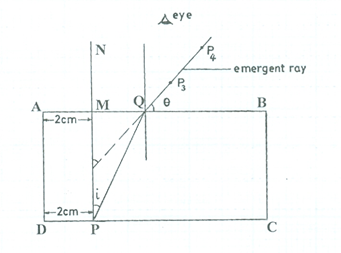Alternative B
Question 2B

You are provided with a rectangular glass prism, cellotex board, four optical pins, four thumb pins and other necessary apparatus.
Using the diagram above as a guide, carry out the following instructions
- Fix a plane sheet of paper on the drawing board.
- Place the rectangular glass prism on the paper and trace its outline, ABCD. Remove the prism.
- Draw a normal NMP to meet AB and DC at M and P respectively such that = = 2.0 cm.
- Trace the ray PQ with two pins, P1 and P2, at P and Q respectively such that angle MPQ = I = 5o.
- Replace the prism on its outline. Trace the emergent ray with two other pins P3 and P4 such that they lie in a straight line with P2 and the image of P1 viewed through the glass prism.
- Measure and record θ, the angle between the emergent ray and face AB of the glass prism.
- Evaluate cos θ and sin i.
- Repeat the procedure for four other values of I = 10o, 15o, 20o and 25o. Tabulate your reading.
- Plot a graph of cos θ on the vertical axis against sin i on the horizontal axis.
- Determine the slope, s, of the graph.
- State two precautions taken to ensure accurate results.
[Attach your traces to your answer booklet]
(b) (i) State the laws of refraction of light.
(ii) Explain what is meant by the statement the refractive index of material is 1.65.Observation
Part (a) Many candidates avoided this question. The few candidates that attempted the question performed averagely. Many candidates could not record sin i and cos to the required accuracy.
Part (b) Candidates’ were able to state correctly the laws of refraction of light but failed to explain the statement “the refractive index of a material is 1.65”.
The expected answers are that candidates should:
- Provide five complete traces showing i, , and the normal(s)
- Measure and record five values of i in degrees
- Measure and record five values of in degrees and in trend
- Evaluate five values of to at least 3 d.p
- Correctly evaluate five values of cos to at least 3 d.p
- Show composite table containing at least i, , cos and sin
- Both axes correctly distinguished
- plot a graph using reasonable scales
- draw line of best fit
- determine the slope of the graph
- state any two of the following precautions.
e.g.
- Pins were erect/vertical
- Error due to parallax was avoided when reading the protractor
- Neat traces/sharp pencil as seen from traces
- Pins P3 and P4 were reasonably separated at least 4cm apart shown on traces
- Refracting surfaces of the block were clean.
b(i) (α) The incident ray, the refracted ray, the normal at the point of incidence all
lie in the same place
(β) The ratio of the sine of the angle of incidence to the sine of the angle of refraction is a constant for a given pair of media Accept n1 Sin = n2 Sin r where the symbols are defined
(ii) The ratio of the speed of light in vacuum (air) to the speed of light in the
material is 1.65.
OR
It means that light travels faster by 1.65 times in vacuum (air) than it travels in the material.
OR
